Most Dangerous Snakes: Every year, snakebites kill between 30,000 and 150,000 people. As a result, they are the world’s most dangerous animals species. Snakes are feared by most people on the planet. “Ophidiophobia” is the label given to those who have abnormal fears. However, given how lethal some of these snakes can be, the worry seems very justified. However, one must wonder if snakes are indeed so hazardous. While the majority of snakes are harmless, we must maintain a safe distance from them.
Snakes having a high venom potency aren’t usually the most harmful to humans. Snake bites, whether poisonous or not, maybe excruciatingly painful.
There are numerous hazardous snakes on the globe, and it’s always a good idea to identify the type of snake you’re dealing with before acting. As a result, we’ve produced a list of the world’s most dangerous snakes so that you can be better informed.
Recommended: Top 9 Fastest Animals in Water
Top 11 Most Dangerous Snakes In The World (With Pictures)
1. The Russell Viper: With 25,000 deaths per year, this snake kills more people than any other animal in India (excluding humans). The worldwide total is substantially larger when we consider that Russell’s viper may be found all throughout the Indian subcontinent, and that sub-species are far more numerous.
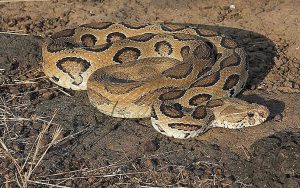
The venom of Russell’s viper, like the venom of the other snakes on this list, is highly deadly, albeit not as potent as the other snakes’. What it lacks in efficiency, it makes up for in quantity, with an adult snake possessing enough venom to kill 20 humans.
Blistering and necrosis of adjacent muscles may occur shortly after the attack, affecting the local tissue around the bite. Within a few hours, swelling and discoloration will extend up the limb and, in extreme instances, to the trunk. Complications from the venom’s devastating effects on the body’s organs generally prove lethal during the next 1 to 14 days.
Kidney failure, brain hemorrhage, blood poisoning, and cardiovascular failure are all common causes of death. While there is an effective antivenom for Russell viper’s bite, it must be provided quickly to avoid complications and stop the venom’s deadly course. Snakebite victims often have significant agony for up to a month after being treated.
The Russell viper’s bite is not only deadly but also excruciatingly painful. Unlike the super-fast acting neurotoxins of snakes like the black mamba, the venom of Russell viper is a hemotoxin, which works through destroying the body’s tissues.
A bite from one of these snakes results in excruciating pain and swelling at the bite site, so you know you’ve been bitten. Within half an hour after the bite, the victim may experience gum bleeding, bloody urine, or bloody coughing. The Russell viper’s venom is particularly brutal, although it is no more hazardous than the venom of many other snakes. The environment and disposition of this snake make it, in our view, the world’s deadliest snake.
Recommended: Advantages and Disadvantages of being a teacher
2. Black Mamba: The black mamba is not just one of the most poisonous snakes on the earth, but it is also large and aggressive. When attacking, the mamba may strike quickly and across a long distance, and it has been known to bite numerous times on occasion. Given all of these features, it’s no wonder that the black mamba is also the world’s deadliest snake.
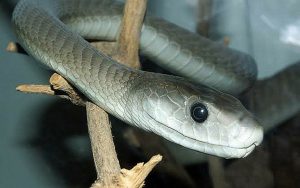
It is not prevalent in the developing world’s more densely populated places. This snake has the greatest fatality rate of any snake in any country where it is native. In South Africa, for example, the black mamba is responsible for fewer than 1% of all snake bites yet kills the most humans.
The venom is neurotoxic that works quickly. It can paralyze a human in 45 minutes and kill it in 7 to 15 hours after killing a mouse in under 5 minutes.
There have been reports of humans surviving black mamba attacks without antivenom, although these appear to be the exception rather than the rule. After a bite, your chances of life are minimal to none if you don’t seek medical help.
Also see: Most dangerous prisons in the world
3. Eastern Brown Snake: Many people believe that the inland taipan in Australia is the deadliest snake on the planet; while it does have the most potent venom of any snake, it is not significantly more poisonous than the venom of the eastern brown snake, and the taipan is not very aggressive. The eastern brown is also considerably larger and more numerous than the inland taipan, making it a more dangerous snake.
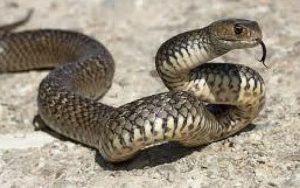
The brown snake, unlike the inland taipan, may be found in inhabited areas. These Snakes feed mostly on small animals and can be found everywhere there are a lot of mice or rats. Their venom’s main aim is to immobilize and kill tiny creatures quickly, but it’s also quite powerful on humans. Eastern brown snakes, which are both swift and aggressive, are responsible for the majority of snakebite deaths in Australia.
Recommended: Countries with the Most Beautiful Women in the world
4. Indian Krait: The krait’s neurotoxic venom is used as a weapon. In India, they are reported to be responsible for 10,000 deaths per year.
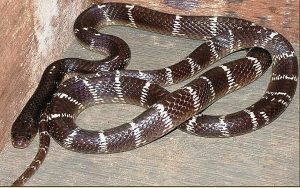
Despite the fact that its small size suggests it should carry less venom, a single bite has enough poison to kill many humans. The krait frequently clings to its victim for a long period in order to get a good dose. Both post-synaptic and pre-synaptic neurotoxins are found in the venom.
These drugs paralyze muscles by attacking the connections between the brain and the nerves. Although there is an antivenom for krait bites, it may be useless if not administered right after because presynaptic neurotoxins might block it. In such circumstances, artificial ventilation is the only option to keep the person alive until the toxins in the body are broken down. Without treatment, the fatality rate can reach 80%, with death occurring four to six hours after a bite.
In the vast majority of situations, krait bites are considered painless. Unfortunately, this can lead to people failing to notice that they’ve been bitten or failing to take bites seriously. Symptoms, such as facial paralysis and stomach aches an hour or two later, usually appear after a lengthy period of time.
Recommended: Most dangerous dog breeds
5. The Saw-Scaled Viper: In southern Asia, the saw-scaled viper has claimed the lives of hundreds of thousands of humans. Despite its small size, this snake makes up for it with sheer numbers. The saw-scaled viper is one of India’s and Sri Lanka’s most common snakes, and it’s the bane of agricultural laborers.
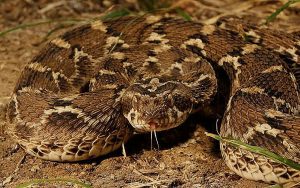
This snake is both common and dangerous. Because of its strong venom, lightning-fast striking, and reputedly violent temper, the saw-scaled viper is responsible for 5,000 fatalities per year in India alone. The ocellated carpet viper, commonly known as the African saw-scaled viper, is Africa’s deadliest snake, killing up to 20,000 people each year.
Even if you live, getting bitten by a saw-scaled viper is something you should avoid. Snakebite seldom results in “dry bites,” yet it almost always contains enough venom to kill. The bite of a saw-scaled viper, which releases a powerful hemotoxin, is known to be excruciatingly painful and cause a variety of unpleasant symptoms. Swelling and burning will occur at the bite site, with symptoms spreading up the affected leg.
Also see: Most Dangerous People In the World 2022: Top 10
6. Puff Adder: The puff adder’s massive girth compensates for its short stature. These ferocious snakes have massive fangs, making them formidable hunters. The puff adder possesses one of the quickest strikes of any snake, despite its slowness and sluggishness, earning it the epithet “lazy“. Rodent victims are killed by the force of a puff adder’s blow and its huge teeth. It has enough venom, though, to kill a huge number of humans.

The term puff adder derives from the snake’s warning behavior of inflating itself to seem larger and emitting a frightening hiss. You should take this warning seriously since the puff adder is Africa’s most lethal snake, killing more people than any other reptile on the continent.
The puff adder’s bad reputation stems in part from its propensity of sunbathing on walkways in the morning and late afternoon. This brings them into touch with humans, which is exacerbated by the fact that these snakes are hesitant to crawl away when approaching footprints are detected. Puff adders, on the other hand, use their excellent camouflage to remain undetected. Unfortunately, as a result of this strategy, the snake can feel obligated to defend itself.
You’ll know if you’ve been bitten by a puff adder because its cytotoxic venom is among the most potent of all vipers, and over half of all envenomation results in death if not treated properly. The bite itself causes a great deal of pain, but that’s only the beginning of a lengthy range of terrible side effects. Puff adder venom has been known to cause tissue necrosis, with severe cases causing bone injury, as well as swelling and internal bleeding.
7. Coastal Taipan: The venom of the coastal taipan is one of the deadliest of any land snake, and it is still extremely hazardous. It does, however, provide enough venom to kill over 200,000 mice in a single bite.

The taipan has the largest teeth of any Australian venomous snake, allowing it to inject its powerful neurotoxin deep into the victim’s tissues. Another rumored fatal trait of the taipan is that it would really pursue people when on the attack and can move at a decent speed. A coastal taipan goes into full assault mode when it feels the need to defend itself.
Dry bites are not to be trifled with; in over 80% of instances, a high dosage of venom is administered, typically in many blows. Each of these quick bites has the potential to inject a similar quantity of venom.
Recommended: Most Popular Countries In Africa 2022: Top 5 Most Famous
8. Blue Krait (BUNGARUS CANDIDUS): The very venomous blue krait belongs to the Elapidae family of snakes and is often referred to as the Malayan krait. This dangerous species, which is present over most of Southeast Asia, grows to a maximum length of around 3.6 feet. Due to its preference for nighttime hunting, the blue krait is regarded as a nocturnal species and is a deadly snake that can cause major harm (and even death) to people. They are easily recognized by their bluish-black crossbands that highlight their yellowish-white bodies.
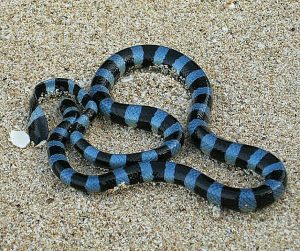
The fatal presynaptic and postsynaptic poisons of the blue krait’s extraordinarily strong venom make it extremely lethal. These potent neurotoxins quickly assault the victim’s central nervous system after biting them, resulting in mental dysfunction and speech impairment minutes after the bite. Other symptoms including paralysis, abdominal cramps, and total blindness are also typical as the venom moves through the bloodstream. Four hours after a bite, total respiratory paralysis typically follows, which can result in asphyxia.
Recommended: Differences Between The Rich And the Poor
9. Belcher’s Sea Snake (HYDROPHIS BELCHERI): A very venomous snake from the Elapidae family is the belcher’s sea snake. It is still regarded as the world’s deadliest and most venomous sea snake. Belcher’s sea snakes are a relatively small species, growing to only 3.3 feet in length at maturity, and were first identified in the 1800s. The snake, which is primarily found in the Gulf of Thailand and the warmer quadrants of the Indian Ocean, is easily recognized by bystanders because to its small head, slender body, and chrome-like coloring that is accented by dark bands.

A human can be killed by a bite from a Belcher’s sea snake within 30 minutes thanks to its very effective combination of myotoxins and neurotoxins. For the most part, it is a great relief that the snake is often regarded as a timid and shy creature that only bites when threatened.
Symptoms of Belcher’s sea snake envenomation include migraine headaches, excruciating muscle pain, cramps in the abdomen, vomiting, lightheadedness, and diarrhea, all of which manifest very quickly. Paralysis and convulsions are frequent side effects as the venom’s potent neurotoxins take over the central nervous system. After then, panic starts to develop along with excessive bleeding. Complete kidney and respiratory failure result from the venom’s penetration of additional body parts, and death follows.
Also see: How to Study Effectively: 10 Smart Tips
10. Dubois’ Sea Snake(AIPYSURUS DUBOISII): The Elapidae family of snakes, which also contains cobras and black mambas, includes the highly venomous Dubois’ sea snake. The Dubois’ sea snake, one of the world’s deadliest snake species, is a very hazardous creature that has the power to kill (or critically injure) people with just one bite. This snake is easily recognized by its relatively lengthy length, wide head, fin-like tail, tan color with dark brown crossbands, and coastal locations throughout Australia and the Indian Ocean.
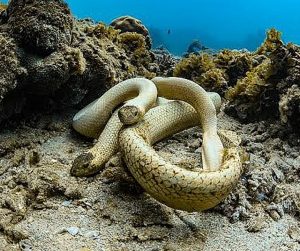
The Dubois’ sea snake has a very strong venom that contains cardiotoxins, nephrotoxins, myotoxins, and postsynaptic neurotoxins. When these chemicals combine, they unleash a devastating onslaught on the snake’s prey, with symptoms emerging minutes after a bite. A Dubois’ sea snake bite commonly causes migraine headaches, severe nausea, vomiting, cramping in the abdomen, diarrhea, and disorientation. Convulsions and paralysis are also frequent once the venom has spread throughout the bloodstream of the host, with kidney failure, cardiac arrest, and respiratory failure being among the three most typical causes of death.
Recommended: Richest Car Companies In The World 2023
11. Beaked Sea Snake (ENHYDRINA SCHISTOSA): Beaked sea snakes, also known as common sea snakes or hook-nosed sea snakes, are venomous members of the Elapidae family of snakes. The beaked sea snake is a particularly hazardous species and is regarded as one of the most venomous sea snakes in the world. Each year, it is to blame for numerous bites and fatalities. Because of its relatively lengthy length, dark gray colour, and white underside, the snake is easily identified. The waters surrounding Southeast Asia, the Persian Gulf, and the Arabian Sea are all home to it.
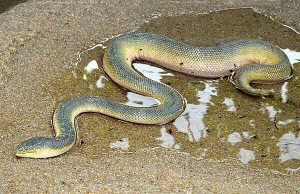
A powerful variety of neurotoxins and myotoxins can be found in the venom of the beaked sea snake. The average venom yield for this species is approximately 7.9 to 9.0 milligrams, but the toxic dose is only 1.5 milligrams, which makes it fatal to humans (making this an incredibly dangerous snake to humans). Following envenomation, symptoms typically appear quickly and include headache, nausea, vomiting, and excruciating abdominal pain. Additionally frequent are nausea and vomiting, which are frequently followed by violent convulsions. Then either kidney failure, heart arrest, or respiratory paralysis occurs (leading to death). The species’ overall mortality rate is not well understood. Although 90% of sea snake bite fatalities and approximately 50% of all sea snake bites (annually) are caused by beaked sea snakes (toxinology.com).
Recommended: Advantages And Disadvantages Of Oral Communication
Conclusion
Snakes have been the subject of many people’s nightmares, and they are among the most feared creatures on the earth even when they are fully awake. We discussed what makes some of them so intriguingly deadly in this article.
Even after death, certain snakes maintain the ability to bite, in case you thought only live snakes were hazardous. These are potentially more harmful because they lose the capacity to control the amount of venom they inject, resulting in increased amounts of envenomation.

Edeh Samuel Chukwuemeka, ACMC, is a lawyer and a certified mediator/conciliator in Nigeria. He is also a developer with knowledge in various programming languages. Samuel is determined to leverage his skills in technology, SEO, and legal practice to revolutionize the legal profession worldwide by creating web and mobile applications that simplify legal research. Sam is also passionate about educating and providing valuable information to people.